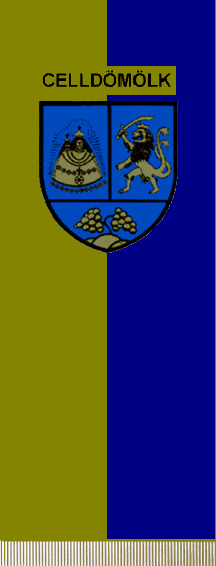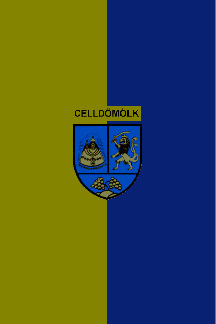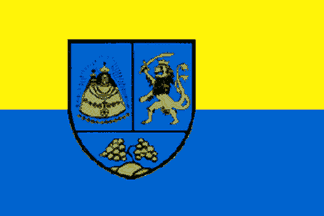 zachary harden
zachary harden
Keywords: hungary | vas | celldomolk | st. mary | vine | kiscell |
Links: FOTW homepage | search | disclaimer and copyright | write us | mirrors

Last modified: 2023-06-03 by  zachary harden
zachary harden
Keywords: hungary | vas | celldomolk | st. mary | vine | kiscell |
Links: FOTW homepage |
search |
disclaimer and copyright |
write us |
mirrors
 image
by István Molnár, 10 March 2001
image
by István Molnár, 10 March 2001
See also:
Upper flag is based on the Res. No. 14/1991 (IX.18.) of the
Community of the Town of Celldömölk and its appendix No. 8. The
second image is based on a photo of a small flag that was sent by
the Community of the Town of Celldömölk.
Celldömölk is a town in Vas County in Hungary on the Little
Hungarian Plain in the Marcal Valley (30 km West from Pápa). The
town has got 11.917 inhabitants (1990 census), nearly all of them
are Hungarians. Neighbouring settlements are: Mersevát,
Kemenessömjén, Kemenesmihályfa, Tokorcs, Mesteri,
Kemeneskápolna, Köcsk, Nemeskocs, Csögle, Egeralja,
Adorjánháza and Külsővat villages.
from <www.freeweb.hu>:
Celldömölk has got five historical parts. The oldest part is
Pórdömölk (the first mention is from 1252 as 'ecclesia Sancta
Marie de Demunk') Pórdömölk was the village of the Abbey of
Dömölk (the first mention is from 1338 as 'monasterii de
Demelk'). The second part is Nemesdömölk (Pór means serf,
Nemes means noble). Its first mention is from 1457 as 'Kysdemelk
or Felsew Demelk'. The settlements were destroyed by the Turks in
1532, 1594, 1620 and 1686. Nemesdömölk became the center of the
Lutherans after 1681. The settlement as a borough or town was a
district seat. The third part, Kiscell was founded by Odo Koptik,
Abbey of Dömölk. He brought along the duplicate of the
devotional object - sculpture of St. Mary of Mariazell. He built
a new chapel and sprang a well. When his workers sprang a well a
great stone fell on a worker. And he didn't die. This was a
miracle and the statue became a miraculous object. In 1745 there
was built the second building of the settlement: a
restaurant. The new settlement had got a name: Kis Mária Cell.
The new settlement became a town in 1790. From the 1850s Kiscell
became the district seat. In 1909 the three villages -
Pórdömölk, Nemesdömölk and Kiscell - were united as
Celldömölk. Celldömölk became an important railway junction.
In 1910 Celldömölk was a village in the Celldömölk district
of Vas County of the Kingdom of Hungary. Number of its
inhabitants in 1910: 4.616; 4.519 (97,9%) Hungarian, 50 (1,1%)
German and 47 (1,0%) other by mother tongue, 3.085(66,8%) Roman
Catholic, 1.081 (23,4%) Lutheran, 385 (8,3%) Jew and 65 (1,4%)
other by religion.
The fourth part is Alsóság. Its first mention is from 1272. It
was a borough later village. In 1910 it was a village in the
Celldömölk district of Vas County of the Kingdom of Hungary.
Number of its inhabitants in 1910: 2.608; (99,7% Hungarian by
mother tongue, 54,7% Roman Catholic, 43,7% Lutheran by religion).
In 1950 it was united with Celldömölk.
The fifth part is Izsákfa. The first mention is from 1435 as
'Isakfalua'. This settlement was destroyed by the Turks too. In
1910 it was a village in the Celldömölk district of Vas County
of the Kingdom of Hungary. Number of its inhabitants in 1910:
574; (99,8% Hungarian by mother tongue, 78,6% Roman Catholic,
20,2% Lutheran by religion). Izsákfa was united with
Celldömölk in 1979. After this union Celldömölk became a
town.
Description of the Coat of Arms: Standing blue shield with
pointed bottom divided into three parts. In the left field there
is St. Mary and a little child Jesus. On their heads there are
crowns with cress. On St. Mary's shoulder there is a crucifix.
This symbol relates to the miraculous object and the historical
Kiscell. In the left field there is a lion putting its tongue on
and in his left hand there is a sword. I think this symbol
relates to the historical Nemesdömölk. In the bottom field
there is a cluster of grapes relates to the vineyards of
Alsóság.
Symbols were adopted on 18 September 1991.
István Molnár, 10 March 2001
1)  image
by István Molnár, 10 March 2001
image
by István Molnár, 10 March 2001
This variant is based on the photo of a small flag.
István Molnár, 10 March 2001
2)  image
by István Molnár, 18 March 2001
image
by István Molnár, 18 March 2001
Today I was in Celldömölk and I have seen this version
flying around the Mayor's Office. I think this is the common
version and the long gold-blue hanging one is the ceremonial
version.
István Molnár, 18 March 2001
va_cl.gif) image
by István Molnár, 14 May 2001
image
by István Molnár, 14 May 2001